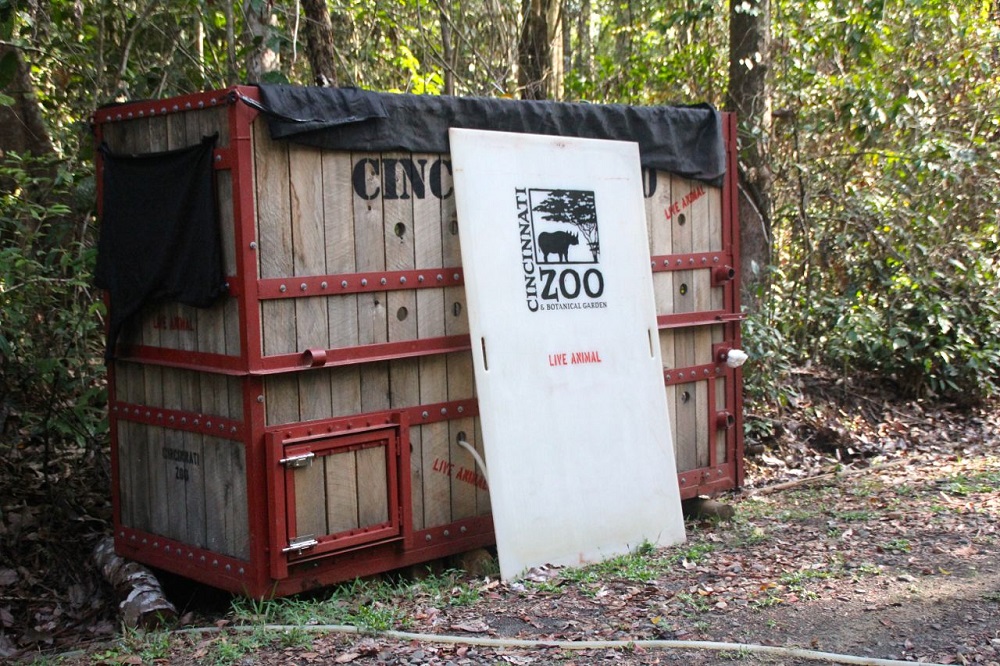- The last Sumatran rhino at the Cincinnati Zoo has been relocated to Indonesia’s Sumatran Rhino Sanctuary.
- Harapan’s parents were sent overseas in the 1990s as part of a captive breeding program meant to rejuvenate the critically endangered species.
- With Sumatran rhinos on the brink of extinction, scientists hope Harapan will help produce a new generation of Indoensian rhinos.
Harapan the rhino is among the last of his kind. His name – it means “hope” in Indonesian – is fitting: scientists are counting on the newly mature Sumatran rhinoceros (Dicerorhinus sumatrensis) to help rejuvenate his imperiled species, of which only around 100 remain on the planet.
In November, Harapan was transferred from the Cincinnati Zoo, where he was born, to the Sumatran Rhino Sanctuary at Indonesia’s Way Kambas National Park. The captive breeding program there recently yielded its first calf: Andatu, the son of Harapan’s older brother, Andalas, who was relocated from Cincinatti in 2007, the year Harapan was born. Andalas has since mated with Ratu, one of three females at the sanctuary and the only one to have given birth.
The arrival of Harapan might help to raise that figure. First, though, he needs to adjust to his new surroundings. It’s a long process: Andalas took two years to get comfortable in the sanctuary, adapting to a new diet, a foreign climate and alien parasites.
“So far, Harapan is doing fine,” Ni Made Ferawati, a veterinarian at the sanctuary, told Mongabay in December as the rhino was being fed. Ferawati’s team monitors Harapan around the clock, routinely checking his blood, urine and feces for abnormalities.

Harapan gained 30 kilograms during his first month in Way Kambas. He was still about 60 kilograms below his ideal weight, though, partly because of his picky eating. “This is natural in the adjustment phase,” Ferawati said. Park staff are trying to get him accustomed to different kinds of food. Sumatran rhinos typically consume about 10% percent of their body weight in food each day.
Harapan will also have to get used to Southeast Asia’s tropical climate. Ferawati expects the relatively dense hair he grew in North America to gradually thin out, as Andalas’ did. And he’ll also have to adjust to the parasites of Sumatra’s jungles, such as blood-sucking ticks.

Harapan’s parents, who were born in the wild, were sent to the U.S. in early 1990s as part of an international effort to captively breed the creatures. Eighteen individuals were shipped abroad as part of the program. By the mid-90s, though, most of them had died, mainly from digestive problems from the food they were given.
Harapan’s mother, Emi, and father, Ipuh, had three children before passing away recently; Harapan’s sister, Suci, has died. Harapan was the last rhino in Cincinatti at the time of his relocation. He “will not contribute anything [to] conservation if he sits in the U.S.,” Widodo Ramono, executive director of the Indonesia Rhino Foundation, told Mongabay last year.


Harapan’s parents were caught in the Kerinci Seblat area of central Sumatra, now thought to be bereft of rhinos. So he and his brother carry unique genes, making them especially valuable to the breeding program.
Genetic diversity is one thing the sanctuary has got going for it: Ratu, with whom Andalas has mated, was caught in southeastern Sumatra’s swampy lowlands, while the female Rosa comes from a hillier area. That more topographically complex upbringing has endowed Rosa with a lean body and pointy horns.
“We plan to work with communities around the national park to plant plants the rhinos like to eat,” said Haerudin R. Sadjudin, who helped found the sanctuary in 1996. A special effort has already been made to do so within the sanctuary. “It’s part of a program to improve the local economy based on conservation.”
Sadjudin and his colleagues know the rhino’s situation is dire. The species was recently declared extinct in the Malaysian state of Sabah. But the scientists at the sanctuary are still trying. They hope to eventually have enough rhinos to release them back into the wild.
In two months, they’re expecting another new arrival: Ratu and Andalas’ second child.
“It’s good news for the program,” Sadjudin said.

Citations:
Rahmadi Rahmad and Ridzki R. Sigit. “Harapan, Badak asal Amerika yang Nyaman di Rumah Leluhurnya.” Mongabay-Indonesia. 9 Feb 2016.













